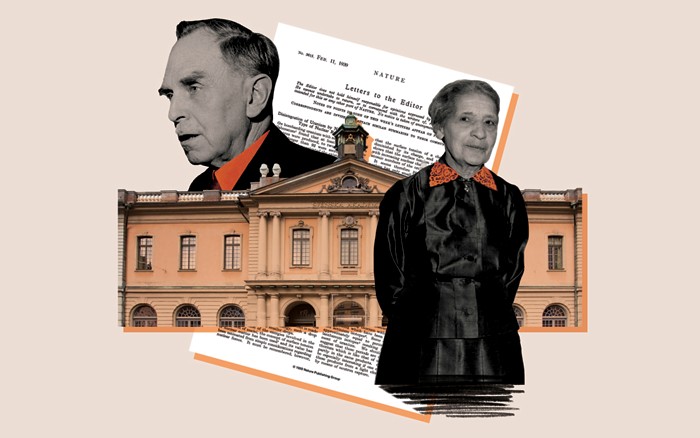Advertisement
Grab your lab coat. Let's get started
Welcome!
Welcome!
Create an account below to get 6 C&EN articles per month, receive newsletters and more - all free.
It seems this is your first time logging in online. Please enter the following information to continue.
As an ACS member you automatically get access to this site. All we need is few more details to create your reading experience.
Not you? Sign in with a different account.
Not you? Sign in with a different account.
ERROR 1
ERROR 1
ERROR 2
ERROR 2
ERROR 2
ERROR 2
ERROR 2
Password and Confirm password must match.
If you have an ACS member number, please enter it here so we can link this account to your membership. (optional)
ERROR 2
ACS values your privacy. By submitting your information, you are gaining access to C&EN and subscribing to our weekly newsletter. We use the information you provide to make your reading experience better, and we will never sell your data to third party members.
ACS News
Nobel Prize–awarding institution receives an ACS HIST award plaque honoring the discovery of nuclear fission
The award recognizes the groundbreaking research that enabled nuclear power and the Manhattan Project
by Nina Notman, special to C&EN
April 18, 2024
| A version of this story appeared in
Volume 102, Issue 12

On March 20, the American Chemical Society’s Division of the History of Chemistry (HIST) presented a 2023 Citation for Chemical Breakthrough Award plaque to the Royal Swedish Academy of Sciences in Stockholm. The award honors the 1939 Nature paper in which Lise Meitner and Otto R. Frisch first described the theory behind nuclear fission.
Established in 2006, the Citation for Chemical Breakthrough Award program recognizes historical journal articles, books, and patents that have advanced the field of chemistry. “This award identifies, honors, and celebrates specific discoveries,” says Jeffrey I. Seeman, the founder and administrator of this award program. HIST has given out 87 awards so far, issuing plaques to sites in 17 countries.
Plaques are given to the departments or institutions where the scientists were based when they made their discovery. The Stockholm plaque honors Meitner; a duplicate plaque for the work was given to the University of Copenhagen in Denmark, where Frisch was based.
Otto Hahn and Fritz Strassmann’s 1939 Naturwissenschaften paper describing the experimental work on which the theory of nuclear fission was based also received a 2023 Citation for Chemical Breakthrough Award. The plaque for this award is on display at the Max Planck Institute for Chemistry in Mainz, Germany.

A Nobel omission
Hahn’s and Meitner’s contributions to the discovery of nuclear fission have not always been so equally acknowledged. The Royal Swedish Academy of Sciences, for example, awarded the 1944 Nobel Prize in Chemistry to Hahn alone for this research, downplaying Meitner’s involvement.
Meitner and Hahn were colleagues at what would become known as the Max Planck Institute for Chemistry for around 30 years, until 1938, when Meitner, an Austrian of Jewish heritage, fled Nazi Germany to the Royal Swedish Academy of Sciences.
“Otto Hahn was the chemist and Lise Meitner was the physicist. She understood the processes and he understood the chemical analysis of the things that they were doing,” says Claes Fahlander, professor emeritus of nuclear physics at Lund University and a member of the Royal Swedish Academy of Sciences. Together Hahn and Meitner discovered protactinium and made many other important early findings related to radioactivity.
Before Meitner left Germany, she and Hahn had been attempting to make transuranium elements by bombarding uranium with neutrons. Hahn and his assistant Strassmann continued the experiments after Meitner’s departure. Hahn and Strassmann realized they were producing barium rather than a new element and wrote to Meitner in late 1938 to ask her if she could figure out why. While walking with her nephew Frisch in Kungälv, Sweden, at Christmas, Meitner realized that when a neutron struck a uranium nucleus, it wasn’t adding to the nucleus as they’d predicted—but instead caused it to explode into two parts.
“When she did calculations, she realized that there is an enormous energy being released when the uranium nucleus splits into smaller pieces, barium and krypton,” Fahlander says. Hahn and Strassmann published their experimental observations in Naturwissenschaften in January 1939. Meitner and Frisch published their explanation for the experimental observations, and coined the term “nuclear fission,” in Nature the following month. These discoveries led to the start of the Manhattan Project, the secret US government program to develop atomic weapons, and later to the establishment of nuclear power plants.
Meitner’s work has long been held in high acclaim by many in the scientific community—she received 30 nominations for a Nobel Prize in Physics and 19 nominations for a Nobel Prize in Chemistry between 1924 and 1967. Many attribute her omission from the 1944 Nobel Prize in Chemistry to a mix of anti-Semitism and sexism.
The Citation for Chemical Breakthrough Award plaque at the Royal Swedish Academy of Sciences was revealed during a ceremony celebrating Meitner’s life and work.
Acid-base chemistry
A third Citation for Chemical Breakthrough Award was given in 2023 for the 1923 article in the journal Recueil des Travaux Chimiques des Pays-Bas in which Johannes Nicolaus Brønsted describes acids as proton donors and bases as proton acceptors. Today, this theory is known as the Brønsted-Lowry acid-base theory. “Every freshman chemistry student learns about Brønsted acid-base theory,” Seeman says.
Over the past century, the discovery of quantum mechanical effects has allowed our understanding of acid-base chemistry to evolve. But Brønsted’s article described the breakthrough that the rest of the research built upon. “This is a history award. Even though there are now quantum chemical theories of acid-base chemistry that are more general and more sophisticated, that doesn’t diminish the achievement of Brønsted,” Seeman says. Two plaques were presented for Brønsted’s breakthrough publication, to the Department of Chemistry at the University of Copenhagen and the Department of Chemistry at the Technical University of Denmark.
HIST will announce the recipients of the 2024 Citation for Chemical Breakthrough Award in the fall. For more information on this award program, visit cenm.ag/chemicalbreakthroughaward.
Nina Notman is a freelance writer based in Salisbury, England.



Join the conversation
Contact the reporter
Submit a Letter to the Editor for publication
Engage with us on Twitter